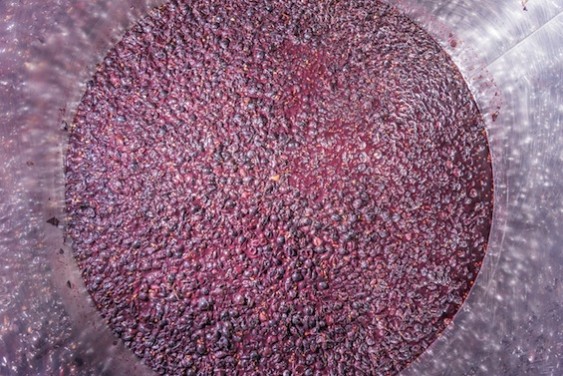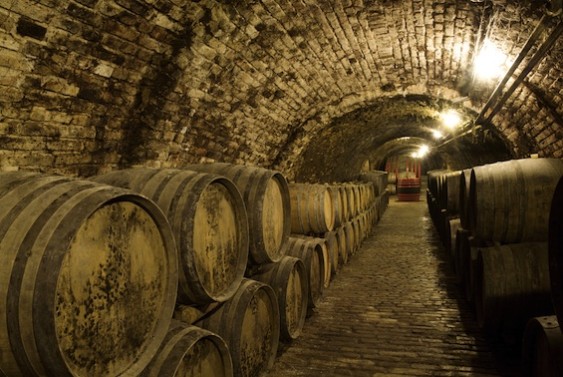Remember in civics class (I might be dating myself by saying I had civics class) where you learned how a bill becomes a law? Well, like the long, laborious process of our nation’s legislative branch, the process by which a grape becomes a wine involves several steps that your average drinker might not know about.

There are a few steps to how a grape becomes a wine…but it’s not complicated.
Just a little preamble (sorry, I have Constitution on the brain) first. Let me just say that I know there are infinite iterations to how a grape becomes a wine that involve steps from the planting of vines, to the work in the vineyards, to harvesting decisions, wine-making equipment, aging practices and more. I’m not talking about all that. All I’m going to discuss here is fermentation, the process by which all that delicious grape juice is chemically transformed into a wonderful, alcoholic beverage. And it’s going to be the simple version.
Now that that’s out of the way, here’s the short of it: yeast that is either on the grapes or that is added to them converts the sugars in the grape juice into carbon dioxide and alcohol.
The Not-Too-Long Version
Here’s the (slightly) longer take. You harvest a bunch of grapes and press them to release the juice. Sometimes you can use whole clusters, sometimes you just prick the skin, other times, you smush them like a monster truck destroying a row of junkers at a rally. It just depends on your style.
You then pump them into a fermentation tank. These are those huge vats you see at wineries. Sometimes they’re stainless steel cylinders, sometimes they’re concrete cubes, sometimes they’re even egg-shaped.

Those huge tanks are for fermentation, and help maintain a healthy temperature for the yeast.
Generally, with red wines, you leave the skin in the mix, while with white wines, you just keep the juice. The skin of those grapes are home to naturally occurring, or indigenous, yeast. Some winemakers just use indigenous yeast, while others employ specially cultured yeasts that are particularly good for making wine and they throw packets of it into the juice. I’ll get to those in another post.
When the yeast find themselves surrounded by the glucose and fructose sugars in the grape juice, they immediately start feasting on the,, digesting them, and expelling two by-products, carbon dioxide and ethanol, which is alcohol.
The key is keeping oxygen out of the mix so that one of the things that the sugars are broken down into, acetaldehyde, is actually converted into ethanol. The second important factor is that there is some sort of release for carbon dioxide so that you don’t end up carbonating your wine. Sparkling Zinfandel, anyone? In big fermentation tanks and at the beginning of fermentation, there’s usually enough carbon dioxide being produced that the tank can be left open at the top for the gas to escape, and it in turn prevents oxygen from entering the wine.

Some fermentation tanks are left open so that carbon dioxide can escape.
When the yeast have gorged themselves to death, they eventually float down to the bottom of the fermentation tank and form a sediment often referred to as the lees. So if you’ve heard that in a winery tour, that’s what they’re referring to, though I’ll cover it in a later post as well.
Fermentation Fail
Among the things that can go wrong and thus alter, interfere with or outright ruin your wine, are the introduction of harmful microbes, and the temperature at which fermentation takes place. Too cold and those yeast stop working. Too hot and they die off. That’s why you see all those stainless steel fermentation tanks with temperature control, and why those Old World wine cellars are generally in cool places or caves carved into rock.
You’ve got to keep the temperature just right (usually around the high-50s to mid-70s depending on the wine) so that the yeast keep working. Winemakers have to keep a special eye on this since the fermentation process actually throws off energy in the form of heat, so left unmonitored, that fermenting juice can really heat up. The chemical process also produces all kinds of compounds that are responsible for those flavors and aromas we all know and love in wine.
Duration Consideration
Fermentation can last for several days up to several weeks depending on all these factors, though the bulk of it generally occurs within the first week or so, and then it tapers off over time. Sometimes while all this is going on, wineries either “punch down” the cap of grape skins that have floated to the surface along with the carbon dioxide, or pump the wine from the bottom of the tank back over the top. This gets a little bit of oxygen into the wine and also extracts more color and flavor from those skins.
Assuming everything is going according to plan, fermentation will naturally stop when the available sugar left in the wine gets very low and the yeast have nothing left to eat.
Now, in some wines, that’s pretty much it. Though some winemakers allow a second type of fermentation called malolactic to take place. When that happens, the malic acid that is present in grape skins, and which can give wine a tongue-tingling, teeth-squeaking sharpness (that can be downright fantastic in some crisp white wines), is converted into lactic acid, which has a creamier texture. Instead of yeast, this fermentation is usually carried out by certain bacteria, and it often happens while the wine is aging in barrel or tank.

Malolactic fermentation usually happens during aging, like in barrels. Just ask a Real Housewife!
Most red wines undergo malolactic fermentation, but the standard with whites is a little more mixed. With a variety such as Riesling or Sauvignon Blanc, you might want to maintain the grape’s natural acidity. While the Real Housewives like their Chardonnay as buttery as possible, so they might prefer a wine that has undergone malolactic fermentation.
After that, it’s pretty much all about the aging, whether in barrel, tank or bottle, duration, conditions and more, but all that is for future posts.
As for the actual transformation of grape juice into wine via fermentation, that’s pretty much it. Not to be crass about it, but when you drink a glass of wine, you’re basically enjoying yeast poop. Delicious, palate-pleasing yeast poop. Bottoms up!

